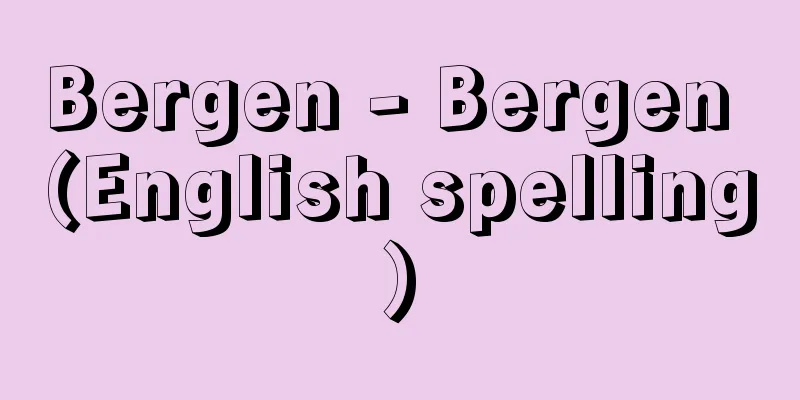Bergen - Bergen (English spelling)

|
Located in the southwest of Norway, it is the second largest city in the country after the capital Oslo. It has a population of 233,892 (2002). It is a port city located at the head of the Byfjord bay, and its western coast is protected from the open sea by the island of Skjægård. The city is surrounded by seven hills less than 700 meters above sea level. The city receives a lot of rain because it is located on the Hardanger plateau, which is 1,700 to 1,900 meters above sea level to the east and receives moist air from the Atlantic Ocean. The city receives 2,006 mm of rainfall annually, and in 1980 it had 201 rainy days. It was founded in 1070 by King Olaf Kyrre (reigned 1066-93), and joined the Hanseatic League in 1350. For over 200 years after that, it dominated trade on the west coast of Norway and developed as a financial center linked to maritime traffic. Until the railway line between Norway and Oslo was completed in 1909, the Hardangervidda behind Norway blocked inland traffic, and people were more interested in trade with Britain than with other parts of the country. In the 1840s, spinning mills were introduced from Britain, which led to industrial development. Today, Norway is a commercial center connecting cities in southwestern Norway, and various industries have developed, including shipbuilding, machinery, food, and textiles. The port also exports marine products and steel, and imports food, wool, and cotton, making it an important trading port on a par with Oslo. The city center developed around the port, and there is a fish market at the back of the port, and fish and flower stalls line the square in front of it, bustling with shoppers. On the north side of the port, along the coast, Bryggen street, there are rows of wooden warehouses with steeply sloping gabled roofs, and it still retains the image of the port that flourished in the Middle Ages during the Hanseatic League era. This area was registered as a World Heritage Site in 1979 (World Cultural Heritage). The south side of the port is a wharf for ships heading to various coastal areas and the inner fjords. In the north of the city is Mount Freyen, which is 320 meters above sea level, and a cable car runs from the east of the port. From the top of the mountain, you can see the city, the port, the distant islands, and the mountain range behind. The city is also the educational and cultural center of the western region of Norway, and has museums, art galleries, and the University of Bergen. It has also produced many cultural figures, including the composer Grieg and the playwright Holberg. [Kiyofumi Takeuchi] [References] | | | |The Bryggen district still retains traces of the Hanseatic League era. The steeply sloping gabled roofs of the wooden buildings create a unique landscape. World Heritage Site "Bryggen" (Norway, registered in 1979) Bergen, Norway ©Shogakukan "> Bergen cityscape Source: Shogakukan Encyclopedia Nipponica About Encyclopedia Nipponica Information | Legend |
|
ノルウェー南西部にあり、首都オスロに次ぐ同国第二の都市。人口23万3892(2002)。ビーフィヨルドの湾奥に位置する港湾都市で、西側沿岸はスケアゴードSkjægård島によって外海から保護されている。また市街地は標高700メートル以下の七つの丘で囲まれている。大西洋からの湿った空気が東側に控える標高1700~1900メートルのハルダンゲル高原にあたるため雨が多く、年降水量は2006ミリメートル、1980年の降雨日数は201日に達した。1070年ノルウェー王オーラフ・キーレOlaf Kyrre(在位1066~93)によって創建され、1350年ハンザ同盟に加わった。その後200年以上にわたってノルウェー西海岸の貿易を支配し、海運と結び付いた金融の中心地として発展した。1909年にオスロとの間に鉄道が完成するまでは、背後に広がるハルダンゲル高原の存在により内陸との交通が遮られ、国内各地よりもイギリスとの海外交易に人々の関心が向けられていた。1840年代にイギリスから紡績工場が導入され、これを契機に産業が発展した。今日ではノルウェー南西部の諸都市を結ぶ商業中心地であるとともに、造船、機械、食品、繊維など多方面にわたる工業が発達する。また港は水産物、鉄鋼などを輸出し、食品、羊毛、綿花などを輸入して、オスロと並ぶ重要な貿易港となっている。 市街地は港を中心に発達し、港の奥には魚市場があり、前の広場には魚や花の露店が並び、多くの買い物客でにぎわう。港の北側、海岸沿いのブリゲン(ブリッゲン)通りには急傾斜の切妻屋根をもった木造の倉庫が並び、中世に繁栄したハンザ同盟時代の港のおもかげを残している。この地区は1979年に世界遺産の文化遺産として登録されている(世界文化遺産)。港の南側は沿岸各地やフィヨルドの奥地へ向かう船の波止場となっている。市の北部には標高320メートルのフレーイエン山があり、港の東からケーブルカーが通じる。山頂からは市街、港、遠くの島々、背後の山並みが一望できる。市はノルウェー西部地域の教育・文化の中心地ともなっており、博物館、美術館、ベルゲン大学がある。また作曲家グリークや劇作家ホルベアなど、多くの文化人も輩出した。 [竹内清文] [参照項目] | | | |ハンザ同盟時代のおもかげを残すブリゲン地区。急傾斜の切妻屋根をもった木造の建物が独特の景観をつくりだしている。世界文化遺産「ブリゲン(ブリッゲン)」(ノルウェー・1979年登録) ノルウェー ベルゲン©Shogakukan"> ベルゲンの町並み 出典 小学館 日本大百科全書(ニッポニカ)日本大百科全書(ニッポニカ)について 情報 | 凡例 |
Recommend
Bonran - Bonran
A translation of the Sanskrit "Brahmāṇḍa.&quo...
client
…In the process, it became clear that counseling ...
Rudolf Carnap
A German-born philosopher who became a naturalize...
Tremolite (tremolite)
Also called tremolasite or tremola. A calcium amph...
Wakatsuki-so
A manor in Soekami County, Yamato Province (presen...
Chichibu belt
It is one of the division names in the Southwest ...
Not applicable
…However, if you break a third party's fence ...
American Party - American Party
Commonly known as the Know-Nothing Party. A chauvi...
Official slave - Kannuhi
〘 noun 〙 Under the ritsuryo system, state-owned sl...
Varignon, P. (English spelling) VarignonP
...One of the reasons why Newton and other Britis...
hard rime (English spelling) hardrime
...It can be thought of as the same way that hail...
Usanovich, M.
...The H + -centered view of Brensted-Lowry can b...
Noto Province
The old name of the province that occupies most o...
Burt Bacharach
American composer, conductor, and pianist. Born i...
Fukushima [city] - Fukushima
A city in northern Fukushima Prefecture. Establish...








![Ryuhoku [town] - Ryuhoku](/upload/images/67cd2b2a63afa.webp)
